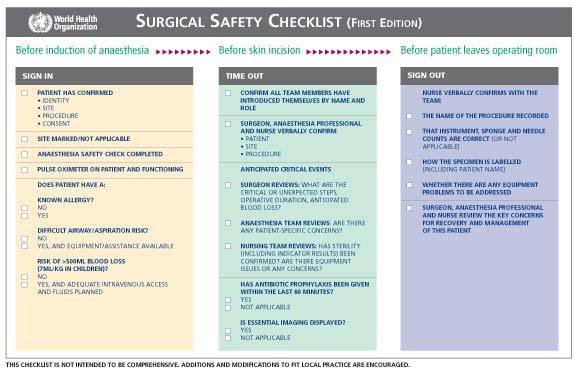[ Fall 2008 ]
The World Health Organization’s surgical checklist

view full-size pdf of the WHO surgical checklist
This first edition of the WHO’s surgical safety checklist has been endorsed by more than 200 professional medical associations worldwide and 20 ministers of health. Three nations, Ireland, Jordan, and the United Kingdom, already have pledged to make it part of their national health care standards.
This fall, WHO plans to publish the full results of the eight-hospital, 3,500-patient pilot study led by HSPH’s Atul Gawande, and to engage 2,500 hospitals by the end of 2009.* Study sites will gather information such as numbers of operations and in-hospital death rates.
A “surgical Apgar”-like score that Gawande devised, which has been validated by the pilot sites, will also be used as a standard measure of surgical outcomes. Much like the score used to evaluate a newborn’s health named for its inventor, anesthesiologist Virginia Apgar, the surgical Apgar measures a patient’s condition at the end of an operation, based on such criteria as blood loss and drop in blood pressure.
By gathering more data, Gawande says, “We’ll know if we’re doing the job of reducing harm.”
For more information, visit WHO’s Safe Surgery Saves Lives site at http://www.who.int/patientsafety/safesurgery/en/
* The eight pilot hospitals include University of Washington Medical Center in Seattle, USA; University Health Network, Toronto, Canada; St. Mary’s Hospital, London, UK; Auckland City Hospital, New Zealand; St Stephen’s Hospital, New Delhi, India; Prince Hamzah Hospital, Amman, Jordan; Philippines General Hospital, Manila; and St. Francis Designated District Hospital, Ifakara, Tanzania.